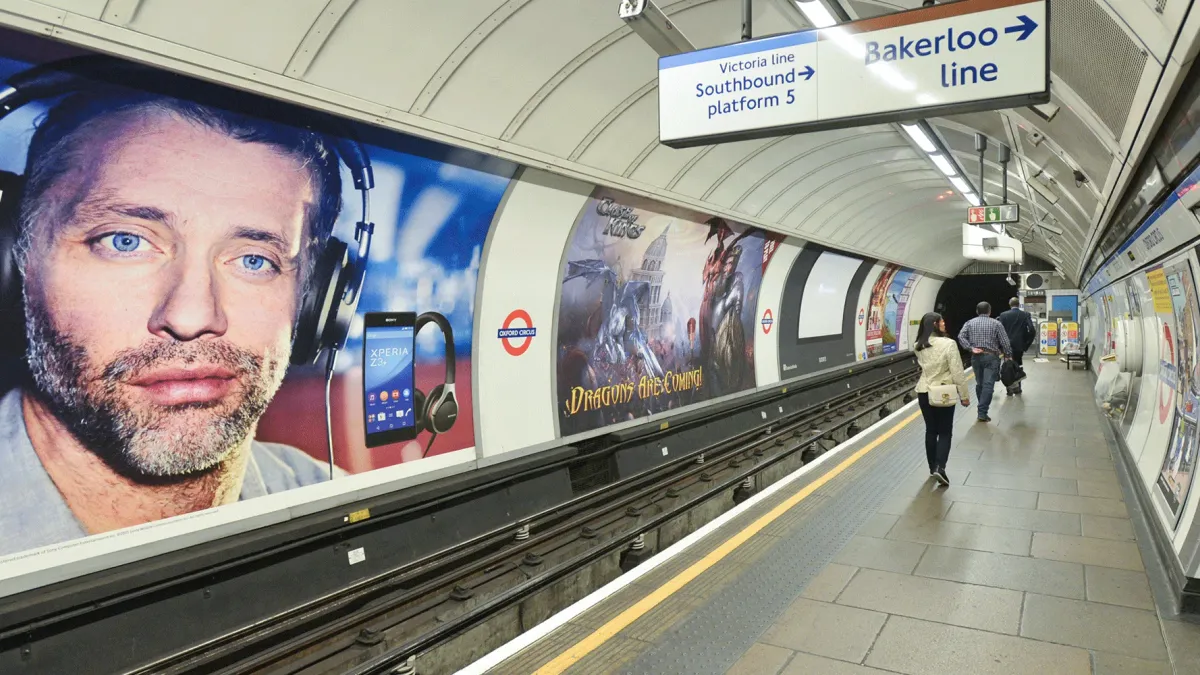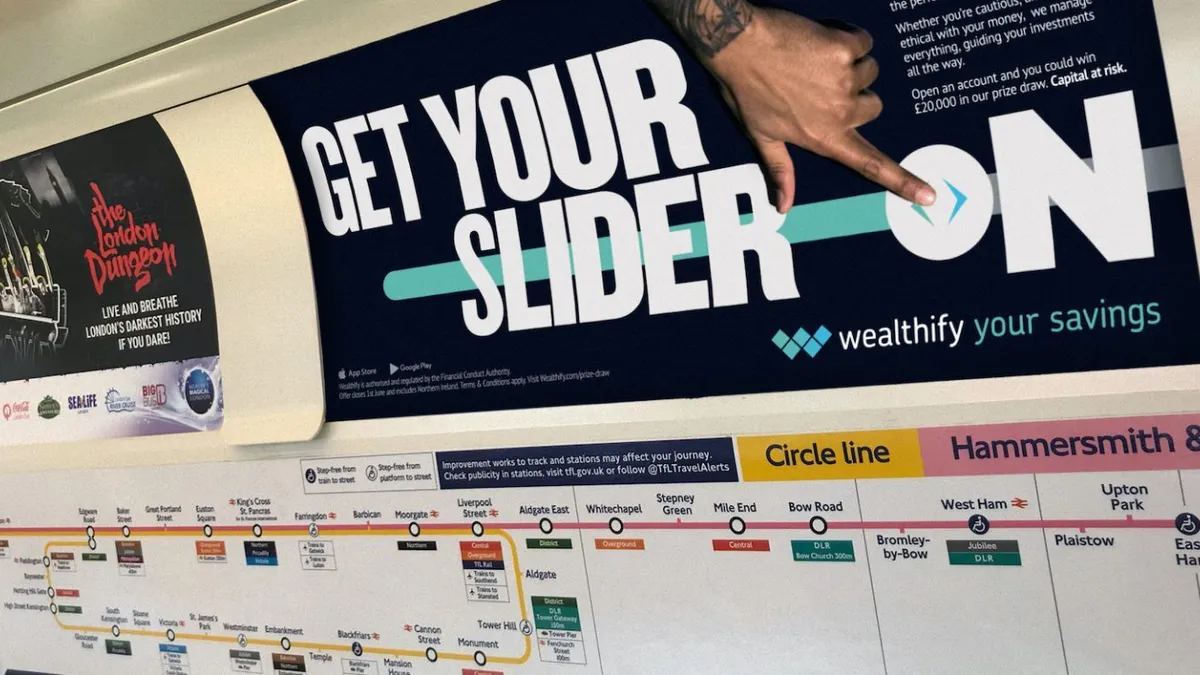
Advertising on the London Underground is about creating a strong presence and real impact. With over 1.3 billion journeys taken across the network every year, the Tube isn’t just a way to travel, it’s where Londoners live, move and make decisions. Every station tells a story, from the business pulse of Bank to the creative buzz of Camden Town.
The key to a successful Tube advertising campaign is location. Choosing the right station connects your brand to the right people at the right time. Whether you’re a retailer aiming for high-spend shoppers, a fintech brand speaking to city professionals, or a lifestyle label chasing cultural trends, success lies in aligning your message with the right location, audience and ad format.
Understanding Station Selection
Each underground station serves a distinct mix of commuters, tourists and professionals. Brands that identify where their audience travels gain stronger visibility and engagement.
Factors to Consider
- Footfall: Stations like Oxford Circus or King’s Cross St Pancras see daily passenger numbers exceeding 80,000.
- Demographics: The audience at Bank or Canary Wharf leans towards finance and tech professionals.
- Purpose of travel: Tourist-heavy areas like Leicester Square and Piccadilly Circus are ideal for lifestyle and entertainment brands.
- Dwell time: Interchange and busy platforms offer longer viewing periods, increasing ad recall.
Matching Stations to Industry
Retail and Fashion
Retail and fashion brands thrive where shoppers gather. Oxford Circus, Bank, Bond Street and Knightsbridge are prime choices. These areas host premium fashion retailers and high-end shoppers.
Brand Examples: ASOS, Ritual and Burberry

Finance and Professional Services
For corporate and financial campaigns, Bank, Monument and Canary Wharf stations are hotspots. They attract senior professionals, investors and decision-makers.
Brand Examples: Beazley and Financial Times
Crypto and Digital Finance
Crypto and blockchain brands perform strongly in stations like Bank, Liverpool Street, and Canary Wharf, where professionals are open to emerging financial trends. These locations connect with early adopters, investors and tech-savvy commuters.
Brand Examples: Coinfloor, Coinbase and Luno
Entertainment and Events
If your brand connects with nightlife, film or culture, Leicester Square, Piccadilly Circus and Covent Garden offer unmatched exposure. These stations welcome millions of leisure travellers.
Brand Examples: Clash of Kings (Game), Ragtime (Musical Show)
Technology and Start-ups
Tech-forward campaigns suit Old Street, Liverpool Street and King’s Cross St Pancras. These stations link to London’s tech corridors and innovation hubs.
Brand Examples: Livy Technologies, Fiverr, Aartisan

Tourism and Hospitality
Stations like Westminster, South Kensington and Green Park attract international visitors. They’re ideal for hotels, airlines, museums and visitor attractions.
Brand Examples: Viator, tipi., and Guernsey
Health and Wellness
With growing interest in fitness and wellbeing, brands in this sector do well at Baker Street, South Kensington and Notting Hill Gate. These stations attract health-conscious commuters.
Brand Examples: Vicks, Plenish and Dettol
Matching Ad Formats to Audience Behaviour
Choosing the right format is as important as picking the right location. Each placement type serves a different purpose and audience moment, from fast-moving commuters to those with longer dwell times underground.
Static Formats
- 4-Sheet and 6-Sheet Posters: Ideal for quick, high-impact visibility in busy concourses.
- 12-Sheet Posters: Great for long-view exposure along corridors and entrances where people naturally slow down.
- 16-Sheet and 48-Sheet Cross Track Posters: Excellent for large-scale visibility on platforms where passengers wait for trains.
- 96-Sheet Cross-Track Posters: A standout format for maximum coverage and dominance across major stations.
Digital Formats
- Digital 6-Sheet and Digital 12-Sheet posters: Perfect for eye-catching, dynamic creatives that grab attention in busy stations.
- Digital Gateway Screens: Positioned in high-traffic station entrances, these large screens are ideal for brand awareness and product launches.
- Digital Escalator Panels: Great for storytelling as commuters move through escalator tunnels, increasing message recall.
- Digital Ribbons: Continuous digital displays along corridors for immersive and modern campaigns.
- Digital 48-Sheet Cross-Track Posters: Command attention on platforms with full-motion creative designed for high dwell times.
In-Carriage and Immersive Formats
- Tube Car Panels: A cost-effective way to stay visible across thousands of daily journeys. Perfect for awareness campaigns.
- Station Takeovers: Full-scale branding opportunities that transform an entire station, perfect for major launches or headline campaigns.

Learn more about diverse advertising formats and find the right fit for your brand’s message.
Regional Considerations
Central London
Stations like Waterloo, King’s Cross and Victoria deliver volume. With an average of 75 million annual passengers each, they’re ideal for national brands seeking mass visibility.
West London
Hammersmith, South Kensington and Notting Hill Gate reach affluent residential audiences. Perfect for lifestyle, luxury and real estate brands.
East London
Stratford, Bethnal Green and Mile End attract younger demographics and students. Great for tech start-ups, recruitment and entertainment campaigns.
North London
Camden Town blends creativity and culture, aligning well with music, fashion and food brands.
South London
Brixton and Vauxhall serve culturally diverse, energetic communities. They’re perfect for brands targeting youth and music audiences.
Why Station Choice Drives ROI
Transport for London data shows advertising recall on the Underground is 16% higher when campaigns appear in stations aligned with the target audience. Matching audience and location maximises engagement and spend efficiency.
Strategic placement can lift conversion rates by over 25%, making station selection one of the smartest investments in your media plan.
Take Your Brand Underground
Whether you’re a luxury retailer, a tech innovator, or an entertainment brand, there’s a Tube station ready to elevate your message. Our team at London Underground Advertising can help you map out your audience journey and match it with the right stations and ad formats.
Get in touch today to start planning your campaign.
FAQs
Which Tube stations have the highest advertising visibility?
Stations like Oxford Circus, King’s Cross, and Waterloo rank among the busiest, offering millions of daily impressions.
How do I choose the best ad format for my brand?
Consider your audience, dwell time and message. Digital escalator panels and 6-sheets are versatile for most campaigns.
Are certain stations better for luxury brands?
Yes. Bond Street, Knightsbridge, and South Kensington attract affluent audiences ideal for high-end advertising.
Can small brands advertise on the London Underground?
Absolutely. With tailored formats and strategic placement, even mid-sized campaigns can achieve strong ROI.
Latest News
26 May 2025 · 3 minute read
by Lilly Ashford
Top 5 London Underground Stations to Advertise At for Maximum Brand Impact in 2025
03 Jun 2025 · 5 minute read
by Lilly Ashford
Marvel on the Move: Iconic London Underground Moments in the MCU
24 Apr 2025 · 3 minute read
by Lilly Ashford
Power Up Your Advertising at Battersea Power Station and Nine Elms
Our Valuable Clients, Past and Present
Schedule a call
Pick a date and time for a call that suits you.
We can go through all the available format options and any other questions you have about successfully launching your next advertising campaign.
Launch Your Tube Campaign Today!
Get your brand in front of millions of Londoners and tourists as they move through the city. Just fill in your details on the form to advertise on the London Underground, and our expert team will be in touch to kickstart your journey towards standout, high-impact results.
Join the 1000s of brands, big and small, who stand out and connect with the transport network’s users.




















